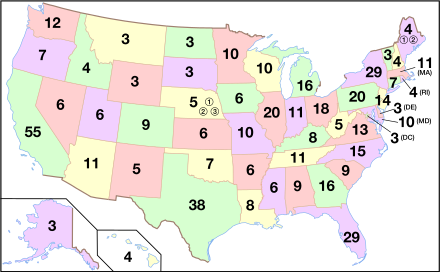
Florida’s oversized role in the 2020 presidential election
Florida has 29 Electoral College votes — tied for third most in the United States. A candidate needs 270 to win the presidency. So winning the Sunshine State already garners the candidate more than 10 percent of the votes he or she needs to win. It is considered the most important of the battleground states. Often called swing states, these states are evenly divided between Democrats and Republicans and the results can go either way.
The battle for victory in Florida is always made interesting by the millions and millions of dollars spent by both sides. It’s also a state that has gotten used to controversy.
For comparison’s sake, I will mention New York with its 29 Electoral College votes, same as Florida. There’s also California, the biggest of all states, which has 55. During a presidential election you can expect New York’s and California’s 84 Electoral College votes to go to the Democrats. Texas, the second largest with 38 Electoral votes, is considered a Republican stronghold.
Then there’s Florida. It swings back and forth depending on the candidate, and it has voted for Clinton (Democrat) in 1996, and Bush (Republican) in 2000 and 2004, then Obama (Democrat) in 2008 and 2012, and in 2016, for Republican Trump. In a period of two decades, during presidential elections, the state voted for two Democrats and two Republicans for president. The winner in Florida in those elections became president of the United States.
In 2020, Florida is up for grabs again. And the presidency is at stake.
It’s become so important that it was the scene of a stolen election in 2000. That was the year that brought George W. Bush to the White House. A very tight election, Al Gore managed to get 50,999,897 votes to George W’s 50,456,002 votes. Yet, George W. Bush managed to win that election in spite of losing the popular vote.
The reason?
Gore lost Florida by 537 votes. In this deeply flawed election George W. Bush ended up with a Florida vote count of 2,912,790 votes and Al Gore had 2,912,253 votes. But all 25 Electoral College votes (population growth in Florida has swollen the EC votes to 29 since then) went to Bush based on a winner-takes-all system.
So Gore garnered more votes than Bush, and Clinton wiped out Trump by 3 million votes. But Trump and Bush ended up in the White House.
Florida will be decisive
Florida will again play an oversized role in electing the next president of the United States. Since these elections are now state-based formulas because of the Electoral College, experts predict that Donald Trump needs to win Florida if he wants to get reelected. They also say Democrats can win without Florida, but… as I wrote earlier, the last six elections have been won by whoever takes the country’s southernmost state.
And what of the numbers? There are currently 13,443,371 registered voters in Florida. Of those, 4,968,302 are registered Democrats (37%), and 4,724,602 Republicans (35%). Democrats lost 7,593 voters from 2018 to 2019. Republicans increased their numbers in the same period by 5,882 voters. But most interesting is the rise of whom many call independents, registered as No Party Affiliation (NPA). Their numbers grew from 2018 by 28,431 voters and now total 3,616,949 in Florida (27%). Since the year 2000, when we had the wacky Bush-Gore race, NPA is, by far, the fastest growing political party in the state.
What does it mean? If you look around the country you will find that it’s very similar most everywhere else. In other words, I believe Americans are losing confidence in both of their major political parties. So NPA will be key in Florida.
Finally, I checked Real Clear Politics to see how the race looks in Florida (it’s way too early to predict what’s to happen, especially when we still don’t have any idea who the Democratic Party candidate will be). Of the current three top contenders on the Democratic side, here are the latest results (RCP takes an average of available polls):
- Joe Biden 49% to Trump’s 46%
- Bernie Sanders 48.5% to Trump’s 46.5%
- Elizabeth Warren 47.5% to Trump’s 47.5%
It’s a statistical tie based on the margins of error. In other words, at this point, anything can happen.
Think of 2015: Who in their right mind thought a Trump victory was possible in 2016?

